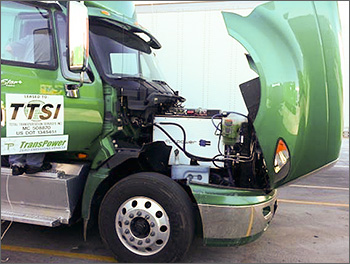South Coast Air Quality Management District Truck Evaluation

Electric drayage truck instrumented for data collection.
Photo by Jon Cosgrove, NREL
NREL is evaluating the in-service performance of electric drayage trucks compared to conventional diesel drayage trucks operated by Total Transportation Services Inc. (TTSI) in and around the ports of Los Angeles and Long Beach in California.
Short-haul movement of cargo containers, also known as drayage, creates substantial air pollution in the vicinity of these ports. Using electric vehicles can help mitigate this problem by eliminating the emissions associated with the use of combustion engines.
The electric vehicles were deployed as part of a Zero-Emission Cargo Transportation project, conducted in partnership with the South Coast Air Quality Management District (SCAQMD), to demonstrate the cost-effectiveness and viability of zero-emission drayage trucks in real-world operation. SCAQMD works with regional stakeholders in the South Coast Air Basin area to support the development and deployment of zero-emission cargo transport technologies. Heavy-duty diesel trucks are one of the largest sources of diesel particulate matter and oxides of nitrogen emissions in this area. The impact on air quality and public health is more pronounced in the surrounding communities along the goods movement corridors near the ports of Los Angeles and Long Beach and next to major freeways in Southern California.
The Class 8 electric drayage trucks under study, produced by TransPower and U.S. Hybrid Corporation, transport cargo containers between the port complex and local rail yards and distribution centers. Utilizing advanced batteries and high-efficiency components, the electric drayage trucks can operate up to 100 miles on a single battery charge while handling gross vehicle weight loads of up to 80,000 pounds.
Based on the field data, NREL will develop a drayage truck drive cycle using the Drive-Cycle Rapid Investigation, Visualization, and Evaluation tool and construct a vehicle model using the Future Automotive Systems Technology Simulator. Relevant data pertaining to drayage truck drive cycles and their electrification potential will be added to the Fleet DNA clearinghouse of fleet vehicle operating data.
For more information about the electric drayage truck evaluation, refer to the Heavy-Duty Vehicle Port Drayage Drive Cycle Characterization and Development reportPDF.
Share
